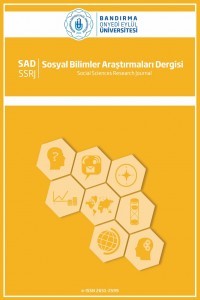CAUSES EXTERNAL DEBT OF THE PRIVATE SECTOR IN TURKEY: A MACROECONOMIC APPROACH
External Debt of the Turkish Private Sector, Short Run External Debt, Long Run External Debt, ARDL, ECM
CAUSES EXTERNAL DEBT OF THE PRIVATE SECTOR IN TURKEY: A MACROECONOMIC APPROACH
___
- REFERENCES
- Abdelhafidh, S. (2011) "Saving, Debt Inflows, and Growth Nexus in Tunisia", Saving and Development, 35(1): 29-53.
- Akduğan, U. (2017) "Determinants of the External Debt Stock in Turkey", Business and Ekonomics Research Journal, 8(2): 183-202.
- Akkaya, A. T. (2010) "International Debt Crises and Sustainability of External Debt of Turkey", (Master Thesis), Çukurova University Institute of Social Sciences, Adana.
- Al-Fawwaz, T. M. (2016) "Determinants of External Debt in Jordan: an Empirical Study (1990-2014)", International Business Research, 9(7): 116-123.
- Awan, A., Asghar, N. and Rehman, H. U. (2011, June) "The Impact of Exchange Rate, Fiscal Deficit and Terms of Trade on External Debt of Pakistan: A Cointegration and Causality Analysis", Australian Journal of Business and Management Research, 1(3): 10-24.
- Bank Of England (2017) https://www.bankofengland.co.uk /boeapps/database/ bank-rate.asp (10.01.2018)
- Central Bank of Turkey Republic (2017) http://www.tcmb.gov.tr/ , (10.01.2018)
- Central Bank of Turkey Republic, EVDS (2017) https://evds2.tcmb.gov.tr/ , (10.01.2018)
- Cordella, T., Ricci, L. A. and Arranz, M. R. (2005, December) "Debt Overhang or Debt Irrelevance? Revisiting the Debt-Growth Link", IMF Working Paper, 223(5): 1-55.
- Dayar, H. and Sandalcı, İ. (2017) "The Development of Private Sector External Debt in Turkey and Impact on the Economy", International Journal of Economic Studies, 3(3): 369-382.
- Dücan, E. (2017, Haziran) "Impact of Foreign Financial Debt of Private Sector on Real Sector and Export", Mehmet Akif Ersoy University Journal of the Institute of Educational Sciences, 9(19): 22-41.
- Dücan, E. and Bakan, S. (2015) "Effects of the Short-Term Borrowing By the Private Sector on The Real Sector: Example of Holland Syndrome", Academic Review International Refereed Journal of Social Sciences (52): 164-185.
- Edo, S. E. (2002) "The External Debt Problem in Africa: A Comparative Study of Nigeria and Morocco", Wiley Online Library, https://doi.org/10.1111/1467-8268.00052.
- Erdem, E., Akdemir, T. and İlgün, F. (2014) "Relationship Between Debt Crisis and Central Bank Independence: Panel Data Analysis for Euro-Zone Countries", The International Journal of Economic and Social Research, 10(1): 61-81.
- Hajivassiliou, V. A. (1987) "The External Debt Repayments Problems of LDC's: An Economic Model Based on Panel Data", Journal of Econometrics, 36(1): 205-230.
- Hallak, I. (2009, May) "External Debt to the Private Sector and the Price Of Bank Loans", Carefin Working Paper, 9(8): 1-23.
- Imimole, B., Imoughele, L. E. and Okhuese, M. A. (2014) "Determinants and Sustainability of External Debt in a Deregulated Economy: A Cointegration Analysis From Nigeria (1986-2010)", American International Journal of Contemporary Research, 4(6): 201-2014.
- Kara, M. (2001) "External Debt Stalemate in Turkey's Economic Growth Process", Suleyman Demirel University the Journal of Faculty of Economics and Administrative Sciences, 6(1): 95-110.
- Karagöl, E. T. (2010, August) "Past to Present External Debt in Turkey", Siyaset, Ekonomi ve Toplumsal Araştırmalar Vakfı, 1-32.
- Lane, P. R. (2004) "Empirical Perspectives on Long-Term External Debt", Topics in Macroeconomics, 4(1): 1-30.
- Pesaran, M. H., Shin, Y. and Smith, R. J. (2001) "Bounds testing approaches to the analysis of level relationship", Journal of Applied Economics, 16(3): 289-326, https://doi.org/10.1002/jae.616.
- Republic of Turkey Ministry of Treasury and Finance, Public Debt Management Reports (2017) https://m.hazine.gov.tr/file/index?id=9e197ba3-9fc7-4c85-ae3f-667386f46599, (10.01.2018)
- Republic of Turkey Ministry of Treasury and Finance, Debt Indicators (2018) https://www.hazine.gov.tr/file/index?id=e71434ab-77b9-4cbf-94b8-c5e9c3345eed, (10.01.2018)
- Schclarek, A. (2004) "Debt and Economic Growth in Developing and Industrial Countries", Lund University Department of Economics Working, PO Box 7082, S-220 07, 1.
- Sürekçi Yamaçlı, D. (2017) "Türkiye'de Parasal İstikrar ve 1923 Yılından Günümüze Para Politikasındaki Gelişmeler", Ankara: Nobel Publishing.
- Sürekçi Yamaçlı, D. and Saatçi, M. (2017) "Economic Determinants of Consumer Inflation in Turkey: ARDL Analysis", Business and Economics Research Journal, 7(3): 53-71.
- Tiruneh, M. W. (2004) "An Empirical Exploration into the Determinants of External Indebtedness" Prague Economic Papers, 13(3): 261-277.
- Udoka, C. O. and Anyingang, R. A. (2010) "Relationship Between External Debt Management Policies and Economic Growth in Nigeria (1970-2006)", International Journal of Financial Research, 1(1): 2-13.
- World Bank (1990) “Turkey - Debt Management and Borrowing Strategy under Macroeconomic Adjustment”, Washington, DC.
- ISSN: 2651-2599
- Yayın Aralığı: Yılda 2 Sayı
- Başlangıç: 2018
- Yayıncı: Bandırma Onyedi Eylül Üniversitesi
HOBBESIAN UNDERSTANDING OF WAR AND PEACE, STATE AND SOCIETY
CAUSES EXTERNAL DEBT OF THE PRIVATE SECTOR IN TURKEY: A MACROECONOMIC APPROACH
Melek KIDEMLİ, Dilek SÜREKÇİ YAMAÇLI
A COMPLICATED RELATIONSHIP BETWEEN FEMINISM AND NEOLIBERAL MULTICULTURALISM
BALIKESİR MERKEZİ ÇEVRESİNDEKİ ROMA İMPARATORLUK DÖNEMİ KENTLERİ
